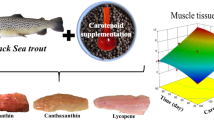Abstract.
This work was undertaken to investigate the effects of various dietary carotenoid sources on the skin pigmentation in a marine teleost, the gilthead seabream (Sparus aurata). In a first trial, homogenous groups of seabream (initial mean body weight: 150 g) were fed, for 9 weeks, one of three diets containing 40 mg/kg of astaxanthin in three different forms: as biomass of laboratory produced Haematococcus pluvialis (LHP), as a commercial source of H. pluvialis (NR) and as synthetic astaxanthin (AST). A control diet (C) without added astaxanthin was also tested. In a second trial, fish (initial mean body weight: 97 g) were fed diets containing 40 mg/kg of each of the following synthetic carotenoids: astaxanthin (Ast), canthaxanthin (Cant), apocarotenoic acid ethyl ester (Z) and lutein (L). At the beginning and every 3 weeks until the end of the experiments, samples of skin from three different skin body locations (forefront, operculum, and along the dorsal fin), and of dorsal muscle and plasma, were withdrawn from five fish per group for subsequent analysis of total carotenoid content and carotenoid composition. Neither growth nor feed efficiency were significantly affected by dietary treatments. In both trials, the dietary carotenoid supplementation increased total carotenoid content in all skin zones sampled, but had no effect on the muscle pigment content. The carotenoid concentration was highest in the skin at the forefront area of the fish, irrespective of the carotenoid source fed. In trial I, the total carotenoid content in the plasma was not affected by the various dietary carotenoid sources, but the plasma astaxanthin content in fish fed diet AST was significantly higher than in fish fed any other experimental diets. In trial II, after 6 weeks of feeding, there were no major differences in the skin carotenoid concentration between fish fed the various diets, but the highest values were observed in fish fed diets Cant and L. Lutein esters and epilutein esters represented almost the totality of the pigments present in the skin samples of seabream, irrespective of the sampling zone. The plasma carotenoid composition was closely related to the carotenoid composition of the diets, irrespective of the dietary carotenoid source fed. However, given that the total carotenoid concentration of the skin and its composition were not significantly affected by the various dietary pigment sources within the constraints tested, it is still difficult to ascertain with absolute certainty the effectiveness of modulating the skin pigmentation in gilthead seabream by dietary means.
Similar content being viewed by others
Author information
Authors and Affiliations
Additional information
Electronic Publication
Rights and permissions
About this article
Cite this article
Gomes, E., Dias, J., Silva, P. et al. Utilization of natural and synthetic sources of carotenoids in the skin pigmentation of gilthead seabream (Sparus aurata). Eur Food Res Technol 214, 287–293 (2002). https://doi.org/10.1007/s00217-001-0475-9
Received:
Issue Date:
DOI: https://doi.org/10.1007/s00217-001-0475-9




